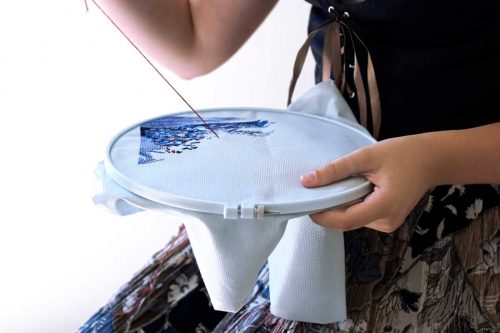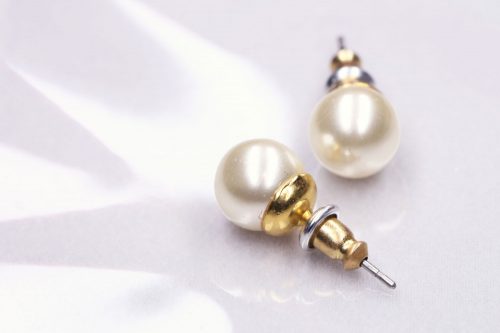Have you been using glass beads for homemade jewelry and now want to know what else you can do with them? Maybe you could change their shape or melt them for other projects. A new hobby is always exciting, but you want to ensure you're proceeding with safety. Can you melt glass beads in the oven? We've compiled some information to satisfy your curiosity and get you started making some new artwork.
Glass beads cannot be melted in a regular household oven; they simply do not get hot enough to melt completely. To melt, glass needs to reach temperatures between 1,400-1,600 degrees Celsius (2,600-2,900 degrees Fahrenheit). Use a kiln to melt glass.
A kiln is a type of oven designed to bake materials at extremely high temperatures, either to cure or melt them. This appliance isn't typically found in homes and though possible to purchase, can be a pricey piece of equipment to buy and operate.
Although you can't use your home oven to melt glass beads, your hopes of melting glass at home can still come true. Read on to find out more about kilns and other methods of melting glass at home, as well as what to do with your glass pieces once you have them.

Melt Glass At Home Using A Kiln
Kilns range in price and variety depending on how you intend to use them. A kiln intended for melting and fusing glass needs to have even heat distribution to melt the glass properly—kilns of this nature range anywhere from a few hundred dollars into the thousands. Operating them can raise your utility bills as well. However, this could be a worthy investment if you also would like to invest in other hobbies, such as ceramic painting or pottery making.
View this tabletop kiln on Amazon
To melt glass in a kiln, place the glass inside and then raise the temperature slowly over several hours. Max out the temperature at 1,600 degrees Celsius (2,912 degrees Fahrenheit) to hard fuse on your glass beads. The total time in the kiln should be an average of 3- to 4-hours. The glass will need to rest in the kiln for many hours after baking.
An abrupt temperature change can cause your glass to crack. The process varies with different kiln models. Always follow the manufacturer's instructions and wear the proper safety equipment, such as goggles and fireproof gloves, at the very least. Using a kiln to melt glass generally allows for larger pieces to be made compared to the other method we will discuss.
Can You Melt Glass Beads In The Microwave?
Instead of purchasing new equipment, try melting glass in an appliance you likely already own--the microwave. There are still some tools you must have to successfully and safely melt glass in the microwave, most importantly, a microwave kiln. These kilns are much smaller than traditional kilns, so you will have to limit yourself on the amount of glass you melt.
There are microwave kiln kits for purchase at very reasonable prices that come with everything you need to get started. The kits are highly recommended because they come with heat-proof gloves which must be worn to prevent extreme burns.
View this microwave kiln kit on Amazon
Using a microwave kiln is fairly simple. Use the following steps as a guide, but always follow the manufacturer's instructions for safe operating.
- Cut kiln paper to fit the base of your microwave kiln and place it on your kiln.
- Place the desired glass beads in your preferred pattern on top of the paper. Glue the glass beads together if desired to ensure the beads do not move around and ruin your design. Try to ensure there is at least half an inch of space between your glass and the edge of the kiln base.
- Place the base in the microwave and gently place the cover on top.
- Set the timer for 3-4 minutes at no more than 70% power on the microwave.
- Put on your gloves after the time has elapsed, and gently lift the lid without removing your kiln from the microwave.
- If the glass is glowing red, replace the lid and carefully remove the kiln from the microwave. If not yet glowing red, add time in one-minute intervals, gently lifting the lid and checking between each interval for glowing red glass.
- Allow the kiln to sit with the lid, still covering the glass for about an hour after removal. Changing the temperature too quickly will cause the glass the crack or shatter.
- Once the glass has cooled, proceed with whatever project your heart desires.
Crafts With Melted Glass
There are many wonderful crafts to be made with melted glass. Most can be managed with a hot glue gun and creative sparkle.
- Glue hooks or ribbons to fused glass to create holiday ornaments.
- Use hot-glue to connect a chunky piece of fused glass to a bale and insert a chain to make a necklace.
- Purchase some earring posts on which to glue your creations and make a unique set of earrings.
- Attach a keyring to make a key chain.
- Have the kids choose their own beads and designs. Help them paint their names and the date on the glass to make a keepsake to be displayed in your home.
- If the kiln you've chosen can fuse larger pieces, make uniquely shaped coasters in various colors.
- Use clear and colored glass together to make a sun-catcher and fill your home with transfused colorful light.
- Decorate your refrigerator with an artsy magnet you made yourself.
- Combine beads into "shards" and surround in resin to create stepping stones for your garden.
- Combine with hanging bells or pipes to create a wind chime for your front porch.
There are no shortages of crafts to be made with glass beads. Stretch your imaginative muscles and create what feels right. There are no mistakes in art!
What Do You Melt To Make Glass?
Glass is made of melted sand. Sand doesn't melt into glass until it reaches about 1,700 degrees Celsius (over 3,000 degrees Fahrenheit). In nature, glass is created by being heated and cooled rapidly, such as when lightning strikes the sand, so sea glass is rarely uniform. Other materials can be added to sand to make it melt at a lower temperature, such as sodium carbonate.
Molten sand needs to be stirred to free the mixture from bubbles and then molded into glass. It is not recommended to try to make glass at home without a professional kiln, supervision, and safety equipment. An incorrect mix of chemicals could make the situation dangerous. Additionally, silica sand that is generally used to make glass is so incredibly fine it can be easily inhaled and cause respiratory distress.
In Conclusion
Melting glass beads might not be an option for your standard kitchen oven, but you can use a kiln to get the job done. Use a traditional kiln or one that fits in the microwave for smaller projects. No matter what you intend to make, always be sure to practice your hobby safely. Wear goggles, fireproof gloves, and always follow instructions when dealing with delicate materials. Above all, please do it for the joy of it.



![Read more about the article Can You Use Hot Glue On Glass? [And How To]](https://craftsbliss.com/wp-content/uploads/2022/06/A-collaged-photo-of-a-glue-gun-and-glass-sheets-500x333.png)

![Read more about the article What Materials Can Be Used To Make Mosaics? [15 Great Options]](https://craftsbliss.com/wp-content/uploads/2021/02/A-gorgeous-circular-mosaic-art-with-using-different-kinds-of-materials-500x333.jpg)
![Read more about the article How To Drill Holes In Glass Beads [8 Steps To Follow]](https://craftsbliss.com/wp-content/uploads/2021/05/Heap-of-shining-transparent-multicolored-faceted-glass-beads-500x333.jpg)

